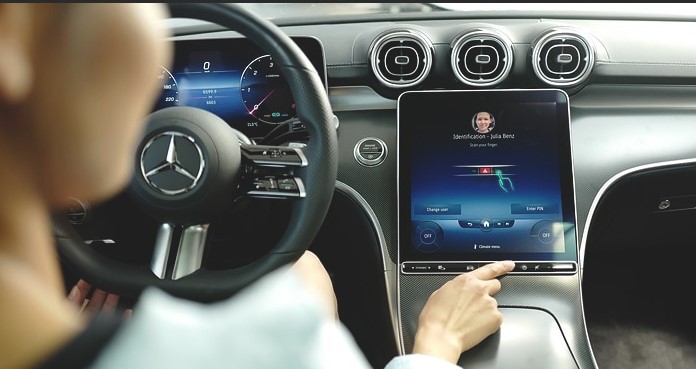Mercedes introduces biometric payment validation in its vehicles

Mercedes already has its own payment system, Mercedes Pay, which allows users to purchase items or services in their cars. Now, the carmaker has partnered with Visa to make the process easier and more widely available via the new Mercedes Pay + feature. A European first that aims to further simplify in-car transactions.
FACTS
-
Instead of having to enter a PIN or use a phone to validate their payment, Mercedes Pay + allows authentication through a fingerprint scan.
-
The authentication solution is based on the Visa Cloud Token Framework technology.
-
The first available models with fingerprint sensors are the EQS and EQE series, S-Class, C-Class and GLC.
-
Visa cardholders can use the payment in their car by linking their card to their Mercedes me user account and activating Mercedes pay+ via MBUX (Mercedes Benz User Experience, the connected multimedia system unveiled at CES last year).
-
Visa Cloud tokens provide an additional layer of security by encrypting sensitive payment information and storing it securely.
-
Mercedes is already considering a wider rollout in other European countries as early as this year.
CHALLENGES
-
A new step towards in-vehicle payment by simplifying the driver experience : The vehicle itself now enables two-factor biometric authentication in conjunction with the fingerprint sensor. There is no longer a need to enter a PIN on the in-car system or use an additional mobile device to verify a payment in the car. Instead, the car itself turns into a payment device, as was beginning to be the case in the initiatives seen earlier.
-
Moving from connected car to on-demand car : Mercedes Pay+ can be used to pay for various digital services such as enhanced navigation functions, smartphone-controlled remote parking (Remote Parking Assist), or on-demand hardware upgrades to the vehicle (rear axle steering with a wider steering angle, for example). Eventually, payments will be extended to other car-related services, such as refueling and fuel payments. The latter function is expected to be the most used over the next five years, accounting for 48 percent of transactions by volume, according to Juniper Research.
MARKET PERSPECTIVE
-
By 2026, 4.7 billion in-vehicle payment transactions are expected worldwide (again according to Juniper).
-
In some countries, German carmaker BMW charges its customers a monthly subscription fee for certain options. In order to have access to the options already integrated in the vehicle, it is therefore necessary to pay a monthly subscription for a period of one month, one year or three years. A practice inaugurated by BMW with CarPlay in 2018. The payment step within the vehicle is therefore a complementary context to be addressed by the manufacturer.
-
More recently, Ford has filed a patent application for an application that allows the system to start locking specific features before fully repossessing the vehicle if necessary.
-
Finally, recall that payment for fueling (or charging for EVs) has been the subject of numerous innovations to simplify the payment path. This is the case, for example, with the Alexa voice-activated charging payment recently offered by EVgo.
